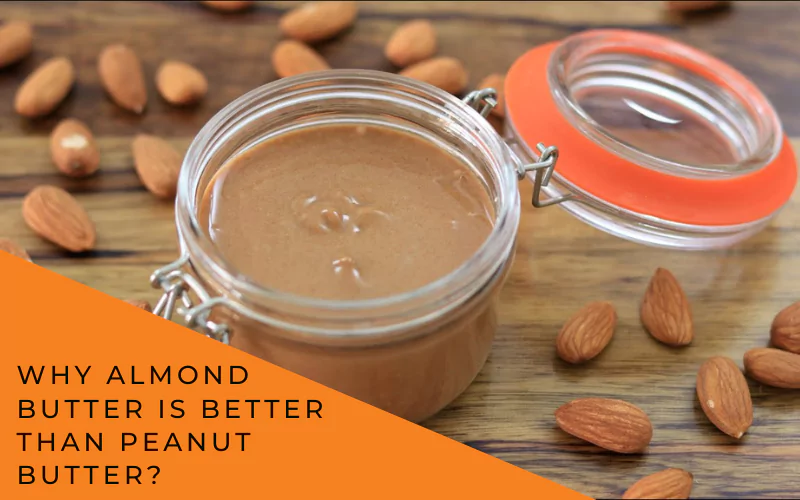As a health-conscious individual, I understand the struggle of finding store-bought almond butter that is free from additives and preservatives. The problem with many commercial almond butter products is that they often contain added sugars, oils, and other unnecessary ingredients. This can be frustrating for those seeking a wholesome and natural alternative.
However, fear not, as I have discovered a simple and satisfying solution – a homemade almond butter recipe with 100% almonds. In this blog post, I will share my personal experience and guide you through the process of creating your own nutritious almond butter from scratch.
Some Benefits Of Homemade Almond Butter
As someone who has made homemade almond butter for quite some time, I can attest to the numerous benefits it offers. Here are some of the benefits I have personally experienced:

Nutritional Value
Homemade almond butter is a rich source of nutrients such as healthy fats, protein, fiber, vitamins, and minerals. It provides essential nutrients that contribute to overall well-being.
Control Over Ingredients
Making almond butter at home allows me to have complete control over the ingredients used. I can choose high-quality almonds and avoid additives like preservatives and excessive amounts of sugar or salt.
Customization
One of the great advantages of making almond butter at home is the ability to customize it according to personal preferences. Whether I want it smooth or chunky, sweetened or unsweetened, I have the freedom to tailor it to my liking.
Freshness
By preparing almond butter at home, I ensure its freshness. This means that I can enjoy the full flavor and nutritional benefits of freshly made almond butter without worrying about expiration dates.
Cost-Effective
While store-bought almond butter can be expensive, making it at home can be more cost-effective, especially when buying almonds in bulk. This allows me to enjoy a nutritious spread without breaking the bank.
Avoiding Additives
Many commercial almond butters contain additives such as stabilizers and emulsifiers. By making my own almond butter, I can avoid these additives and enjoy a more natural product.
Why Almond Butter Is Better Than Peanut Butter – 3 Reasons
Know that I have personally found almond butter to be a superior choice over peanut butter for several reasons. Here are three key reasons why I believe almond butter is better than peanut butter:

Nutritional Value
Almond butter is packed with nutrients such as vitamin E, magnesium, and healthy fats. It also contains more fiber and less saturated fat than peanut butter. This makes it a healthier option for those looking to maintain a balanced diet.
Allergen-Friendly
For individuals with peanut allergies, almond butter is a great alternative. It provides a similar taste and texture to peanut butter without the risk of triggering allergic reactions. This makes it a versatile choice for those with dietary restrictions.
Rich Flavor Profile
Almond butter has a naturally sweet and nutty flavor that sets it apart from peanut butter. Its rich taste adds depth to various dishes and snacks. Whether used in smoothies, spreads, or baked goods, almond butter enhances the overall flavor experience.
Nutrition Of Almond Butter Vs Peanut Butter
| Nutrient | Almond Butter | Peanut Butter |
| Calories | 196 | 188 |
| Total Fat | 18g | 16g |
| Saturated Fat | 1.4g | 3g |
| Monounsaturated Fat | 9.4g | 8.2g |
| Polyunsaturated Fat | 3.4g | 4.4g |
| Protein | 7g | 7g |
| Carbohydrates | 6g | 6g |
| Fiber | 3g | 2g |
| Sugar | 1.5g | 1.5g |
Ways To Use Almond Butter
Almond butter is a delicious and nutritious alternative to traditional peanut butter. It is made from ground almonds and has a creamy texture and slightly sweet taste. There are numerous ways to enjoy almond butter, and here are five creative ideas to help you incorporate it into your daily meals.
Almond Butter and Banana Sandwich
A classic combination, almond butter and banana sandwiches are a tasty and healthy alternative to traditional peanut butter and jelly sandwiches. To make this snack, spread a generous layer of almond butter on one slice of whole-grain bread, then add sliced bananas and top with another slice of bread. This sandwich is perfect for a quick and nutritious breakfast or a satisfying afternoon snack.
Almond Butter and Apple Slices
A simple and healthy snack, almond butter and apple slices provide a satisfying crunch and a touch of sweetness. To prepare this snack, spread a thin layer of almond butter onto apple slices or use a small knife to core and slice the apple, then spread the almond butter directly onto the apple wedges. This snack is perfect for on-the-go or as a mid-day treat.
Almond Butter Smoothie
Almond butter can easily be added to smoothies for an extra boost of protein and healthy fats. To make an almond butter smoothie, blend together almond butter, a frozen banana, a cup of almond milk, a spoonful of honey, and a handful of spinach. This smoothie is an excellent way to start your day or refuel after a workout.
Almond Butter Cookies
For a healthier twist on traditional cookies, try making almond butter cookies. To make these cookies, combine almond butter, honey, an egg, and a pinch of salt in a bowl. Roll the dough into small balls and press them down onto a baking sheet. Bake at 350°F for about 10 minutes or until the edges are golden brown. These cookies are perfect for dessert or as a treat for guests.
Almond Butter and Chocolate Dip
For a sweet and indulgent treat, make an almond butter and chocolate dip. Combine almond butter, melted dark chocolate, and a splash of milk in a bowl. Whisk until smooth, then serve with fresh fruit or graham crackers for dipping. This dip is perfect for a dinner party or a fun family activity.
How To Store Homemade Almond Butter?
Now that you know ways to use almond butter, it’s important to understand how to store homemade almond butter properly to maintain its freshness and quality. As someone who enjoys making almond butter at home, I have learned a few tips on storing it effectively.
Refrigeration
After preparing homemade almond butter, I always transfer it to an airtight container. Then, I place it in the refrigerator. The cool temperature helps to preserve the almond butter and prevent it from going rancid. When stored in the refrigerator, homemade almond butter can last for several weeks.
Freezing
If I make a large batch of almond butter or if I want to store it for an extended period, I opt for freezing. Freezing homemade almond butter is simple – I portion it into smaller containers or freezer-safe bags and then place them in the freezer. This method ensures that the almond butter stays fresh for several months.
Avoiding Moisture
It’s crucial to keep moisture away from homemade almond butter as it can cause spoilage. Therefore, I make sure that the containers or jars used for storage are completely dry before transferring the almond butter into them. Additionally, I avoid using wet utensils when scooping out almond butter from the container to prevent introducing moisture into it.
Shielding from Light and Heat
I store my homemade almond butter in a dark and cool place to shield it from light and heat. Exposure to light and heat can lead to oxidation and degradation of the almond butter’s quality. Therefore, I keep it away from direct sunlight and any sources of heat in the kitchen.
Almond Butter Recipe
Well, I love making almond butter at home. It’s a simple and delicious alternative to regular butter, and it’s packed with nutrients. Here’s my favorite almond butter recipe:

With Milk
To make almond butter with milk, I start by blending roasted almonds in a food processor until they form a thick paste. Then, I add a splash of milk to achieve the desired creamy consistency.
With Coconut Milk
For a dairy-free option, I substitute regular milk with coconut milk. The result is a rich and creamy almond butter with a hint of coconut flavor.
With Waffle
Spread this homemade almond butter on warm waffles for a delightful breakfast or snack. The combination of nutty almond butter and fluffy waffles is simply irresistible.
With Dates
Adding dates to the almond butter gives it a natural sweetness and a slightly chewy texture. It’s perfect for spreading on toast or using as a dip for fruit slices.
With 100% Almonds
For a pure and wholesome almond butter, I use 100% almonds without any added ingredients. This results in a rich and nutty flavor that’s hard to resist.
With Chocolate
To satisfy my sweet tooth, I sometimes mix in some melted chocolate to create a decadent chocolate almond butter. It’s great for dipping fruit or drizzling over desserts.
With Cocoa Powder
Another way to infuse chocolate flavor is by adding cocoa powder to the almond butter. This creates a delicious spread that pairs well with toast or crackers.
Without Eggs
All these almond butter recipes are egg-free, making them suitable for those with egg allergies or dietary restrictions.
How To Soften Almond Butter?
When it comes to softening almond butter, there are a few effective methods that I have personally found useful.
Room Temperature Method
When it comes to softening almond butter, one of the simplest ways is to let it sit at room temperature for some time. I usually take the jar out of the refrigerator and leave it on the kitchen counter for a few hours. This allows the almond butter to gradually soften as it reaches room temperature. It’s important to give it a stir before using it to ensure an even consistency.
Warm Water Bath Method
Another method I have used is the warm water bath technique. When the almond butter is too firm, I fill a bowl with hot water and then place the jar of almond butter in it for about 10-15 minutes. The gentle warmth from the water helps to soften the almond butter, making it easier to spread or use in recipes. It’s crucial to make sure that no water gets into the almond butter during this process.
Microwave Method
In situations where I need to soften almond butter quickly, I turn to the microwave method. I transfer the required amount of almond butter into a microwave-safe bowl and heat it in short intervals of 15-20 seconds, stirring in between each interval. This helps to soften the almond butter without overheating or burning it. It’s essential to keep a close eye on it to prevent any overheating.
Should I Make Almond Butter In A Food Processor Or Vitamix Blender?
Personally, I’ve tried making almond butter in both a food processor and a Vitamix blender. While both can do the job, there are some key differences to consider.
Food Processor
In my experience, using a food processor to make almond butter is more budget-friendly and accessible. It’s a great option if you’re just starting to explore homemade nut butter. However, it may take longer to achieve a smooth consistency, as you’ll need to stop and scrape down the sides frequently. The power of a food processor is also limited compared to a high-speed blender like a Vitamix.
Vitamix Blender
Using a Vitamix blender for making almond butter is a game-changer. It’s significantly faster and more efficient, thanks to its powerful motor and ability to handle tough ingredients. The Vitamix can produce a smoother, creamier almond butter in a shorter amount of time. However, it’s a more expensive option and not as widely accessible as a food processor.
Almond Butter Flavor Variations
| Flavor Variation | Description |
| Classic Almond Butter | Made from roasted almonds with a rich, nutty flavor. |
| Honey Almond Butter | Almond butter blended with natural honey for a sweet and nutty taste. |
| Chocolate Almond Butter | Combines the creamy texture of almond butter with the rich flavor of chocolate. |
| Vanilla Almond Butter | Infused with vanilla extract for a fragrant and aromatic twist to traditional almond butter. |
| Spicy Almond ButterIncorporates spices such as chili or cayenne pepper for a spicy kick to the smooth almond butter. | |
| Maple Almond Butter | Features the addition of maple syrup for a sweet and indulgent flavor profile. |
How Long Does Almond Butter Last In The Fridge?

Well, based on my personal experience, almond butter can last in the fridge for about 6-9 months. However, it’s essential to check for any signs of spoilage, such as an off smell or taste, before consuming it. Proper storage in an airtight container can help maintain its quality and freshness for a longer period.
My Tips For The Best Almond Butter
Last but not least, here are my top 5 tips for the best almond butter:
Choose high-quality ingredients
Look for almond butter made from 100% almonds with no added sugar, palm oil, or other additives. This ensures that you’re getting a pure, natural product that tastes great and is beneficial for your health.
Check for freshness
Fresh almond butter has a rich, creamy texture and a delicious aroma. To make sure you’re getting the freshest almond butter, check the label for a “best by” date or look for a manufacturer that offers a freshness guarantee.
Opt for natural roasting
Natural almond butter is made by cold-pressing almonds, which helps to retain their nutritional benefits and flavor. Avoid almond butter that has been roasted at high temperatures, as this can result in a less flavorful and less healthy product.
Experiment with different textures
Almond butter comes in various textures, from smooth to chunky. Experiment with different consistencies to find the one that best suits your preferences and the way you plan to use it. For example, a smooth almond butter is great for spreading on toast, while a chunkier variety is perfect for adding to smoothies or baking.
Store properly
To maintain the freshness and quality of your almond butter, store it in a cool, dark place, away from direct sunlight and heat sources. Transfer it to a sealed container to protect it from moisture and air, which can cause it to spoil more quickly.
Conclusion
In conclusion, making almond butter at home using 100% almonds is a simple and rewarding process. Not only does it result in a delicious spread, but it also provides numerous health benefits. By following the steps outlined in this recipe, you can enjoy a nutritious and flavorful almond butter that is free from additives and preservatives. Incorporating this homemade almond butter into your diet can contribute to a well-rounded and wholesome approach to nutrition.
FAQs
What Can I Do With Almond Butter?
You can spread almond butter on toast, add it to smoothies, or use it as a dip for fruits and vegetables.
Is Almond Butter Healthy Than Peanut Butter?
Almond butter is often considered healthier than peanut butter as it contains more unsaturated fats and various essential nutrients.
Why Is Almond Butter So Expensive?
Almond butter is expensive due to the high cost of almonds, which require significant water and resources to cultivate.
What Is Almond Butter Good For?
Almond butter is good for providing healthy fats, protein, and essential nutrients, supporting heart health and offering a versatile ingredient for various recipes.
How Long Will Homemade Almond Butter Last?
Homemade almond butter can last for about 2-3 weeks if refrigerated, maintaining its freshness and flavor when stored properly.

Rebecca Wojcik
Rebecca Wojcik, a highly skilled and accomplished nutrition expert, is an experienced Registered Dietitian Nutritionist, Registered Yoga Teacher (200 hr), and successful female entrepreneur.






